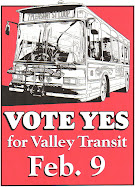FREQUENTLY ASKED QUESTIONS
What transportation services are provided by Valley Transit?
Valley Transit provides a fixed route service, Dial-A-Ride, Job Access, and a vanpool. The fixed route system has seven routes that cover the Walla Walla and College Place urban area. Most buses run at 30 minute intervals on weekdays from 6:15 a.m. to 5:45 p.m. After that, a downsized service runs from WWCC to College Place in the evenings until 8:40, and on Saturday afternoons from 12:15 to 6:10 p.m.
The Dial-A-Ride program uses minibuses and is provided for people 70 or older, or whose disability prevents their riding regular buses. Over 4200 people are currently registered for this service, which allows them to maintain their independence, including staying in their own homes and accessing services.
Job Access is a federally funded program for eligible low-income workers, to allow them to obtain and keep employment. This minibus service, a partnership with WWCC, DSHS, WorkSource, and BMAC, provides transportation to and from work when needed outside Valley Transit service hours.
What is the Vanpool program?
Vanpool is a Washington State program encouraging vanpooling to reduce road congestion and commuting costs for workers. When gas prices were over $4.00, the demand for vanpools was high, and the State paid most of the cost of several vans acquired by Valley Transit. Gas prices—and vanpool demand—are expected to rise again as the world economy recovers.
The biggest customer of vanpool vehicles in our community is the Department of Corrections. Many penitentiary employees come from the Tri-Cities, and some Walla Wallans work at Coyote Ridge Correctional Facility in Franklin County. There are also vanpools to sites at Prescott, Vista Hermosa, and Hanford, with others forming.
Why do I see some buses running without many passengers?
With its 2600 riders per day, the average Valley Transit bus carries 27 passengers per hour, but they are not all on the bus at the same time. Passengers board at various points along the route and get off at different destinations, including job, store, professional office, school, market, restaurant, theater, library, home, or another place. There may be many or few passengers on board at any point, though the total number carried each trip is high.
Buses also have peak and off-peak hours. Roads and parking lots are often empty but are built to absorb peak demand. All buses run at full capacity during peak hours, and have fewer riders at other times. Running different bus fleets, such as large buses for peak times and small buses for off-peak hours, isn’t good economics and would be more costly for the system.
Valley Transit is constantly evaluating its bus routes for greatest efficiency and to assure that important destinations are covered, and plans to continue to do so.
For more information, email transitcampaign@charter.net or info@valleytransit.com, go to http://www.transitcampaign.org/, or http://www.valleytransit.com/, or call 522-0399 or 525-9140.




